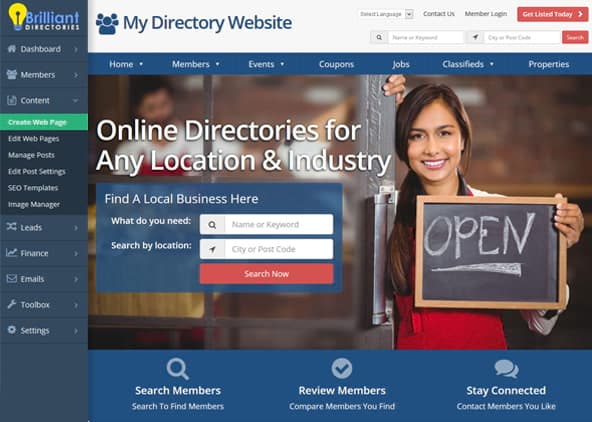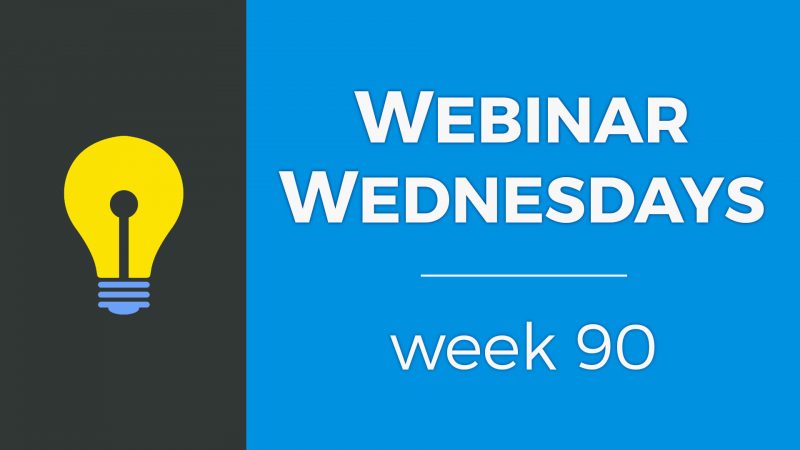
Key Topics:
- 2:46 – New Editor: Image Upload with Pre-Made Elements
- 5:26 – Maps: Start Pin on Primary Country
- 6:58 – Alerts: Notify Admin via Email when Private Member Chat is Flagged
- 7:39 – Search: Dynamic Category Filtering – Broad Match Filter
- 11:07 – Speed: Lazy Load Google Maps and Various Other Updates
- 11:45 – Reviews: Email Notification Settings for Member Reviews
- 13:37 – Add-On: File Upload for Forms (final stage of QA)
- 14:36 – Integrations: BD API + Ability to Send Data INTO BD Site via Zapier, Pabbly, etc.
- 15:14 – Domain Settings: Email Authentication, Security, Integrations, SSL & More
- 16:08 – Have any speed tests been run on existing websites to determine the performance of the recent updates?
- 18:04 – Will unclaimed listings be able to receive email notifications when they receive a review?
- 21:09 – 5 Ways to Rocket Boost Your Website Speed
- 21:56 – Why Website Speed & Load Times are Important
- 23:36 – How Much Should You Care About Website Speed?
- 25:39 – Speed Considerations 101
- 29:30 – NEW: Enable Resource Delivery via CDN
- 30:39 – NEW: Only Load Google Maps when Requested
- 31:45 – NEW: Use ImageKit for Image Delivery
- 38:52 – Developer Hub >> Image Settings
- 40:20 – ImageOptim.com/online
- 44:26 – Reviewing the mobile page speed score of a BD website
- 53:33 – Enabling new Front-End Optimization settings on a BD website and disabling third-party tools to improve speed score
New Features
Coming Soon
Tip of the Week
Questions & Answers

 AI-Generated Transcript – Please excuse any inaccuracies
AI-Generated Transcript – Please excuse any inaccuracies
New Editor: Image Upload with Pre-Made Elements (00:02:46)
- The ability to have pre-made elements, pre-made blocks, with blog articles was released a few weeks ago, allowing admin blog contributor membership plan users to write a blog article, add images, and choose from pre-made blocks while writing, (00:02:47).
- A new editor was created to allow members to upload images without accessing the core media manager, where company logos and brand images are stored, and also gives members the ability to pull in pre-made blocks into their blog posts if chosen, (00:03:14).
- The new editor can be enabled on a post type, such as community articles, by going to edit post settings, searching for the post type, customizing the form, and selecting the “Froel Editor with Image Upload and Pre-made Elements” option, (00:04:12).
- The “Froel Editor with Image Upload and Pre-made Elements” option allows members to construct more rich and vibrant articles, while the other option, “Frauela Text Editor with Image Upload, Media Manager Access, and Pre-made Elements”, is for admin use only, (00:04:42).
- Once the new editor is enabled, members can pull in pre-made blocks to create richer posts, and this feature can be enabled or disabled by the admin, (00:05:08).
- The new editor provides members with the ability to upload images and use pre-made elements, while keeping the core media manager accessible only to admins, (00:03:18).
Maps: Start Pin on Primary Country (00:05:26)
- The map on the site, which appears on the lead form or when filling out a profile for the first time, previously displayed the entire world, but now it will try to frame the primary country set in the general settings of the website (00:05:26).
- The primary country is set in the general settings of the website, and changing this setting will update the map to frame the newly selected country, such as Australia (00:06:09).
- To change the primary country, users can go to the general settings, then localization, and select the new primary country from the search results (00:06:17).
- Once the primary country is set, the map will frame the country by default, and when a more specific address is entered, the pin will show the selected location (00:06:38).
- The new functionality works by default and does not require any additional setup, it will automatically start landing the pin on the primary country (00:06:53).
Alerts: Notify Admin via Email when Chat is Flagged (00:06:58)
- The private member chat feature allows members to send each other one-on-one private chat messages, and if something gets out of hand, one of the members has the ability to close the chat and flag it (00:07:04).
- When a member flags a chat, the admin of the website will be sent a simple notification with a link to the chat thread that links to the admin area, providing live notifications (00:07:18).
- The notification is sent to the admin when a private chat between two members is flagged by one of those members, allowing the admin to take immediate action (00:07:26).
- The flagged chats can be viewed in the admin area, and with the new notification feature, admins will be informed as soon as a chat is flagged, enabling them to respond promptly (00:07:29).
- The notification feature is a quality of life improvement for those using the private member chat, enhancing the overall administration experience (00:06:59).
Search: Dynamic Category Filtering – Broad Match Filter (00:07:39)
- The dynamic category filter add-on has been updated to include a new feature that allows for narrow match filtering, which enables users to filter search results to only include members who match all of the selected subcategories, rather than just any of them (00:07:40).
- Previously, the dynamic category filter add-on would add checkboxes to the sidebar, allowing users to filter search results, but it would only increase the number of results shown, rather than narrowing them down (00:07:53).
- The new feature can be enabled by going to the advanced settings and searching for “dynamic”, then turning off the “broad match” option, which is on by default (00:09:14).
- With the broad match option turned off, the search results will narrow down as more subcategories are selected, allowing users to find members that meet all of the specified criteria (00:09:30).
- This feature can be useful for a variety of industries, such as hotels, accommodations, medical, or legal, where users need to find specific members that meet certain criteria (00:10:43).
- The dynamic category filter add-on can be used to create a search function similar to those found on websites like Kayak (company) or Amazon (company), where users can quickly and easily find what they are looking for (00:09:53).
- To use the narrow match filtering feature, users simply need to select the subcategories they are interested in, and the search results will automatically update to show only the members who match all of the selected criteria (00:10:31).
Speed: Lazy Load Google Maps and Various Other Updates (00:11:07)
- The topic of speed updates is being covered, with a focus on improvements that can enhance the overall performance of web pages (00:11:07).
- One of the key updates is the ability to lazy load Google Maps, which means the JavaScript will only load when it is needed or requested by the visitor, rather than loading on every webpage (00:11:11).
- This update is expected to reduce page load speeds and minimize bloat on web pages, as Google Maps was previously one of the largest pieces of JavaScript that could slow down page loading (00:11:12).
- In addition to the Google Maps update, other various updates have been made to improve speed and reduce unnecessary loading of JavaScript (00:11:37).
- These updates are anticipated to result in improved speed scores across the board, indicating better overall performance and efficiency (00:11:42).
Reviews: Email Notification Settings for Member Reviews (00:11:45)
- Email notification settings for member reviews can be controlled by the admin, allowing them to turn auto notifications on or off, which was not previously possible in the admin area (00:11:46).
- The notification settings for member reviews can be found in the interactions tab, under member reviews, where a new tab called notifications is available, containing simple settings to notify the admin and members when a review is submitted (00:12:17).
- The notifications tab includes options to notify the admin when a review is submitted, with a yes or no setting, and an email template that can be edited if needed (00:12:28).
- The admin can also choose to notify the member when they receive a review, with an on or off setting, allowing members to get notified when they receive a review on their profile (00:12:42).
- Additionally, there are settings to notify the submitter that the review has been received, and another option to send a notification email when the review is manually approved and made public on the website (00:12:51).
- The email templates for these notifications can be used to add calls to action, such as joining a Facebook group or visiting other parts of the website, providing opportunities for touch points with members and visitors (00:13:18).
Add-On: File Upload for Forms (final stage of QA) (00:13:37)
- The file upload add-on is technically complete and has been in development for a couple of months, with the development team having to consider various security aspects for public file upload fields in forms (00:13:38).
- The file upload add-on will allow users to upload files such as PDF resumes or images when submitting leads or custom forms, making it a useful feature for applications and other uses (00:13:42).
- The support team is currently creating documentation, including videos, to accompany the file upload add-on and ensure a smooth release, which is expected to happen in a few weeks (00:13:48).
- The release of the file upload add-on will be announced, and updates will be posted on Facebook to keep users informed about the progress and availability of the feature (00:14:30).
- The file upload add-on is considered a great addition to the existing features, and its completion is a significant milestone, with the development team deserving appreciation for their efforts (00:13:52).
Integrations: BD API + Ability to Send Data INTO BD Site via Zapier, Pabbly, etc. (00:14:36)
- Additional Zapier web hooks have been released to send data out from a BD website, and final QA is being conducted to send and port data into a BD site from Zapier, Pabbly, or other similar tools (00:14:37).
- The ability to send data into a BD site from Zapier, Pabbly, or other tools will allow users to import feeds, members, leads, or posts from other third-party services into their BD website (00:14:45).
- The development is aimed at enabling users to rapidly import feeds from other third-party services into their BD website using tools like Zapier, Pabbly, and others (00:15:07).
- Users will be kept updated about the progress and developments through the Facebook group (00:15:09).
Domain Settings: Email Authentication, Security, Integrations, SSL & More (00:15:14)
- The domain settings are being expanded to include email authentication settings, security settings for the website, integrations related to the domain name, SSL management, and other features, all of which can be accessed through the domain manager (00:15:14).
- The goal of these updates is to turn the domain manager into a command center that ensures the health and vitals of the domain and website are in good shape, with all important features turned on for business needs (00:15:36).
- The updates aim to provide a comprehensive set of tools to manage the domain and website, including email authentication, security, and integrations, to keep the online presence in good shape (00:15:22).
- Viewers are encouraged to ask questions or provide comments about the updates, and a Q&A session will be held later to address any inquiries (00:15:58).
- The domain manager will be developed to include various features such as changing the domain name, managing SSL, and other important settings to ensure the website’s health and security (00:15:18).
Have any speed tests been run on existing websites to determine the performance of the recent updates? (00:16:08)
- Speed tests have been run on existing websites to determine the performance of recent updates, with baseline benchmarks showing good results, including 80s and 90s percent scores (00:16:41).
- The addition of third-party resources, such as Google ads or live chat tools, can bring page scores down, but the new settings can help balance this out and improve scores (00:17:05).
- An example of a site that was worked on showed an improvement in Google page speed from 30 to 40 on mobile to 65, and from a lower score to the high 80s on desktop, after turning on some of the new settings (00:17:17).
- The speed of a site can be affected by various factors, including the addition of JavaScripts and third-party resources, and it is not necessarily due to something being done wrong by the team (00:17:47).
- General maintenance and the application of actionable tips can help improve site speed, with some tips to be covered in the tip of the week segment (00:17:53).
Will unclaimed listings be able to receive email notifications when they receive a review? (00:18:04)
- Unclaimed listings will be able to receive email notifications when they receive a review, but only if the listing was imported with the actual email of the business, allowing them to receive notifications and respond to reviews (00:18:27).
- Claimed listings will also receive email notifications when they get a review, and this feature can be used as an incentive for businesses to claim their listings, especially if they care about their online reputation (00:18:46).
- To respond to reviews, users must be members, but anyone can write and read reviews, providing a way to encourage businesses to engage with their online presence (00:19:19).
- Editing reviews for grammar and spelling is a common practice to maintain the quality of the reviews and the overall brand, and it can be done without changing the context of the review (00:20:26).
- Robert mentions that he manually manages his listings and encourages businesses to claim their listings by allowing them to respond to reviews, which can help improve their online reputation (00:18:52).
- The discussion highlights the importance of maintaining a professional and high-quality online presence, including reviews, to attract and retain customers (00:19:07).
- Allowing users to edit reviews for minor touch-ups, such as grammar and spelling, can help improve the overall quality of the reviews and the user experience (00:20:33).
5 Ways to Rocket Boost Your Website Speed (00:21:09)
- The discussion begins with an introduction to a topic about boosting website speed, sharing five ways to achieve this goal (00:21:09).
- The topic of website speed is popular among users, and the conversation will cover basic information about website speed and load times before diving into recent updates and actionable steps (00:21:27).
- The recent updates pertain to website load times and page speeds, and the team has made some changes to improve these aspects (00:21:43).
- The conversation aims to provide users with actionable steps they can take on their own to improve their website’s speed, specifically for those with Brilliant Directories websites (00:21:52).
- The five ways to rocket boost website speed will be shared, and the topic is expected to be helpful for users who want to improve their website’s performance (00:21:16).
Why Website Speed & Load Times are Important (00:21:56)
- Having a fast website is better than having a slow website, as it provides a more enjoyable experience for visitors, allowing them to browse more pages when the website loads smoothly and quickly (00:21:56).
- A website that loads quickly will encourage visitors to engage with the website more, especially if it is a membership website, as it could encourage them to sign up after finding out more information about the website and seeing other registered members (00:22:42).
- A fast website can increase the chances of landing a sale, as a better performing website allows visitors to browse more pages and engage with the website, leading to a higher likelihood of conversion (00:23:01).
- Website speed is also important for search engine optimization, as search engines like Google, Microsoft Bing, and others favor faster websites over slower ones, although it is only one factor among thousands that they consider when determining search result rankings (00:23:11).
How Much Should You Care About Website Speed? (00:23:36)
- Website speed is an important aspect to consider, but it should not be the only thing to focus on, and obsessing over it can be counterproductive, as a fast website with poor content will not be successful (00:23:36).
- A website’s content and visitor engagement are crucial for its success, and spending too much time optimizing website speed without paying attention to these factors can be a waste of time (00:23:53).
- It is essential to keep website speed in mind, but not to the point of obsession, and instead, focus on creating good content and engaging with the community, as they will be forgiving of minor issues with page speed (00:24:11).
- The analogy of restaurants can be applied to websites, where a “hole in the wall” with good food (content) can be more successful than a fancy restaurant with poor food, similarly, a website with good content and engagement can be more successful than one with poor content but fast speed (00:24:45).
- Having a good relationship with the community and maintaining reasonable Performance indicator (KPIs) and benchmarks for website speed is important, and if there are any obvious issues with website speed, it should be reported to the team for improvement (00:25:12).
- The team is always working on improving website speed, and several updates have been released recently to make a significant difference in this area, and they will continue to work on it, so others do not need to obsess over it (00:24:31).
Speed Considerations 101 (00:25:39)
- Website speed and page load times are affected by the size and number of elements on a webpage, with smaller and lighter pages loading faster, while larger pages with many elements, such as high-quality images and third-party tools, will load slower (00:25:39).
- Stacking multiple third-party tools can slow down a website, as these tools add heavy resources that consume a lot of bandwidth, so it’s essential to consider the value they provide versus the speed cost when deciding whether to use them (00:26:21).
- When using third-party tools, it’s crucial to consider whether the embed code needs to load on all pages or just specific areas of the website, as loading them on all pages can slow down the website (00:26:57).
- Some of the top offenders when it comes to third-party tools that use a lot of resources include Google dynamic display ads, live chat tools, and social networking plugins, such as Twitter and Facebook plugins, or simple share buttons (00:27:19).
- Instead of loading all third-party tools on every page, it’s recommended to use them like “tapas meals” – small and specific to certain pages or areas of the website, to avoid overloading the website with too many resources (00:28:21).
- By strategically loading third-party resources and keeping only the necessary ones, it’s possible to have the desired functionality without sacrificing website speed (00:28:51).
NEW: Enable Resource Delivery via CDN (00:29:30)
- A Content delivery network (CDN) has been subscribed to by Brilliant Directories for all default resources that need to load on a Brilliant Directory’s website, which is beneficial for sites with international users and will load the site more efficiently for visitors (00:29:30).
- The setting to enable resource delivery via CDN can be found in the advanced settings, and it can be easily located by searching for the keyword “optimization” (00:29:56).
- Enabling the “Enable Resource Delivery via CDN” setting will allow default resources to be delivered from Brilliant Directories’ CDN instead of loading locally from the domain name, making the site load more efficiently (00:30:10).
- To enable this setting, users simply need to turn it on, and it will start delivering default resources from the CDN, making the site come alive more efficiently (00:30:13).
- Searching for the keyword “optimization” in the advanced settings will bring up a checklist with the “Enable Resource Delivery via CDN” setting as one of the first three options (00:30:02).
NEW: Only Load Google Maps when Requested (00:30:39)
- Google Maps is considered a significant piece of bloatware on sites that utilize maps, and efforts have been made to optimize its loading, resulting in improved scores (00:30:40).
- The optimization involves only loading Google Maps when requested by the visitor or when the page needs it, which has been achieved after several months of work on the Google Maps JavaScript (00:30:51).
- To enable this optimization, users can simply toggle a switch, but they may need to address potential conflicts with customized widgets, for which alerts and instructions will be provided (00:31:05).
- The setting to only load Google Maps when requested can be found in the advanced settings under optimization, and users should turn it on, then address any warnings that appear, and finally re-enable the setting to save the changes (00:31:26).
- If a customized widget is found to be conflicting with this optimization, users will receive an alert with instructions on how to edit or disable the widget before re-enabling the setting (00:31:31).
NEW: Use ImageKit for Image Delivery (00:31:45)
- ImageKit is a third-party tool that offers a free plan with 20 gigabytes per month, which can serve images from its Content delivery network, and this can improve website speed as measured by tools like Google PageSpeed Tools and GT Metrics (00:31:45).
- ImageKit can automatically convert images to the WebP format in real-time, which is a format that speed tools love, and it can be set up by creating an account, copying and pasting the provided URL for the CDN, and then images will load from ImageKit (00:31:50).
- To demonstrate the effectiveness of ImageKit, a page speed test was conducted using Google PageSpeed, and the initial score was relatively good, even with optimizations turned off, and the test was done on a website with some content, including member images and blog articles (00:32:53).
- Setting up an ImageKit account involves signing up for a free account, verifying an email address, creating a slug for the URL, and choosing a region for image serving, which can be based on the primary country of the majority of users (00:34:36).
- After setting up the ImageKit account, the next step is to add external storage, which involves clicking on the “external storage” option, adding a new storage, and giving it a nickname, and this will allow images to be served from ImageKit (00:35:25).
- The goal of using ImageKit is to reduce image file size and improve page load times, and this can be tested by comparing the file size of an image before and after using ImageKit, with the expectation that the image size will be reduced after using ImageKit (00:34:01).
- To set up image upload with pre-made elements, a nickname is given, and the URL of the website is selected, choosing between http or https, with the base URL being the website’s URL (00:35:41).
- A URL endpoint is created by clicking “URL endpoint” and “Add new”, allowing for a unique identifier to be generated, which can be used for multiple websites (00:36:07).
- The URL endpoint is then attached to an existing origin, and the URL is copied and saved, with this process taking around 30 seconds to a minute to set up (00:36:38).
- The copied URL is then pasted into the advanced settings under “Use Content delivery network for images”, and the changes are saved (00:37:03).
- Using Image Kit for image delivery is recommended, as it serves images in WebP format, cutting the size of the images and improving page load times, with Image Kit providing 20 gigabytes per month for free (00:38:21).
- The image is saved as a webp image, resulting in a significant size difference, with the example showing a reduction from 72 kilobytes to 5 kilobytes (00:37:52).
- The use of Image Kit can improve page speed scores, and it does not require any additional actions beyond pasting the URL into the advanced settings (00:38:40).
Developer Hub → Image Settings (00:38:52)
- The image settings section in the Developer Hub of the Directories admin allows administrators to set reasonable sizes for images, preventing members from uploading excessively large images, such as those that are 6000 pixels wide, which can be done by visiting the image settings section (00:38:54).
- Administrators can review and adjust the image settings to ensure they have reasonable sizes, and if unsure or noticing unusual sizes, such as 8000 or 6000, they can click the restore default button to revert to safe sizes (00:39:16).
- The image settings enable proportional scaling down of large images to the maximum width and height set, enhancing image optimization and delivery, and preventing large images from taking over the site or web pages (00:39:50).
- If a member uploads a large profile photo, such as a 6000-pixel image, it will be scaled down to the maximum width and height set in the image settings, ensuring that the site and web pages are not overloaded with large images (00:39:53).
- To reset the image settings to default sizes, administrators can click the restore default button as many times as needed, and then click save changes to apply the updates (00:40:15).
ImageOptim.com/online (00:40:20)
- Uploading images to a media manager can sometimes result in large file sizes, especially if the images have a lot of metadata, such as location tags and date tags, which can increase the file size, and using a tool like ImageOptim can help reduce the file size (00:40:20).
- ImageOptim is a free tool that can reduce the metadata and shrink the size of images significantly, making it a useful resource for those who build landing pages or upload images to their media manager (00:40:49).
- To demonstrate the effectiveness of ImageOptim, an example was given where a screenshot of a page was saved as a JPEG in Adobe Photoshop, resulting in a file size of 432 kilobytes, and then optimized using ImageOptim, which reduced the file size to 233 kilobytes (00:41:22).
- It is generally recommended to keep large images under 200 kilobytes, and using tools like ImageOptim or ImageKit can help achieve this, with ImageKit being able to convert images to a WebP format that is less than a tenth of the size of a JPEG image (00:41:56).
- ImageOptim is a simple and free tool that can be used to optimize images before uploading them to a media manager, and it is a great resource for those who are building landing pages or custom squeeze pages (00:43:55).
- In addition to using ImageOptim, other settings can be enabled to increase the speed of loading images, such as enabling the Content delivery network resources, lazy loading for Google Maps, and using ImageKit, which can all be found in the developer hub (00:43:32).
Reviewing the mobile page speed score of a BD website (00:44:26)
- The discussion begins with an appreciation for recent speed updates and an expression of gratitude for feedback, with a user seeking assistance with improving the mobile page speed of their website, which is currently slow despite being satisfied with the desktop speed (00:44:28).
- The mobile page speed issue is attributed to potential JavaScript issues that could be improved, and a tool like GT Metrics is used to assess the website’s performance, yielding a decent score of 82 and 93, with some alerts and suggestions for improvement (00:45:34).
- The server response time is identified as a potential issue, possibly due to the use of tools like Ad Plug and Facebook login, and it is suggested to turn these tools off and on to determine their impact on the website’s speed (00:45:55).
- The mobile score is 47, which is considered low, and the report suggests reducing unused JavaScript, with Ad Plug being a potential culprit, and the user is asked about the usage of Google Tag Manager, which is only being used for universal Google Analytics (00:46:07).
- The website’s home page images are identified as an area for improvement, with the suggestion to use properly sized images, as the current images are almost double the required size, which can impact the website’s speed and sharpness (00:47:23).
- The images on the home page are specifically highlighted, with a recommendation to use images that are slightly bigger than the area they occupy, but not excessively large, to achieve a good balance between sharpness and speed (00:47:48).
- The use of GT Metrics and other tools is emphasized as a way to assess and improve the website’s speed, with the goal of achieving a better score and providing a better user experience (00:45:20).
- The images being uploaded are likely too large and can be resized by cutting the width down by 50% to avoid alerts about properly sizing images (00:48:31).
- Image kits have settings to size images on the fly, including granular settings for sizing images in the space they’re filling, which can be explored in their documentation (00:48:49).
- The size of a specific image is 55 kilobytes, which is likely a high-resolution image that can be resized without losing quality (00:49:11).
- Removing some JavaScript loaded on the site, such as Facebook and Google login, can help improve the site’s score, and these can be turned back on later (00:49:40).
- Temporarily removing the Google Tag Manager, Google Analytics, and ad plug can help determine if they are affecting the site’s score (00:50:19).
- The background slider can affect page scores, and using a static image instead may improve the score (00:51:19).
- Running the GT Metrics test again after making changes can help determine if the score has improved, and the results can be compared to the previous score (00:51:07).
- The mobile score increased to 58 and the desktop score increased to 92 after making some changes, but further investigation is needed to determine the cause of some alerts (00:52:01).
- The goal is to improve the site’s performance by updating images on the home page and addressing other issues, with the aim of achieving higher scores, particularly for mobile, which is considered challenging due to third-party scripts and numerous images (00:52:14).
- For mobile scores, 60s and 70s are considered good, 80s are stellar, and 90 is rare, so the target is to reach at least 60 or 75 for mobile and into the 95 range for desktop (00:52:35).
- It is suggested to keep the existing scripts on the site as they are important, but it is unclear if the Google Tag Manager is necessary since it is not loading, so it will be added back to the site (00:52:48).
- The plan is to sort out the images and then post an update in the Facebook group to get a second look and potentially use the site as a case study to improve its performance (00:53:11).
- Lindsay is introduced as a guest, and after unmuting her microphone, she greets Jason and thanks him for his patience, indicating that she had been waiting to join the conversation (00:53:26).
Enabling new Front-End Optimization settings on a BD website and disabling third-party tools to improve speed score (00:53:33)
- The Apprenticeships Directory website has been live for three years and has thousands of images, which may be causing slow speed on the website, making it a potential candidate for Image Kit (00:53:41).
- The website has various features such as a Facebook chat and a share module, which can affect the load time of pages, and it may be beneficial to load these features only on specific pages like blog articles or member profiles (00:54:26).
- Upon reviewing the website, it was found that the level of images seems normal, but there are additional share features that appear when hovering over an image, which could be the same share tool (00:54:45).
- The website’s speed score was checked using GT Metrics, which showed that the structure is good, but the largest contentful paint (LCP) is 3.9 seconds, which should be closer to two seconds, and the initial server response time is 2.6 seconds, which should be below 600 milliseconds (00:55:36).
- To improve the website’s speed, it was suggested to turn on a Content delivery network (CDN) and make some adjustments to the settings, which may involve resetting the member profile and fixing some warnings, such as the one related to the Google Maps feature (00:56:30).
- The process of fixing these issues involves a three-step process, including going to the edit post settings and making adjustments to the member listings, which can be followed by anyone experiencing similar issues (00:56:56).
- To restore the default code for the member listing, the default code can be restored under the profile page design, which is a useful tool in case something goes wrong with the source code of post types, allowing it to be reverted back to its default state (00:57:05).
- An ImageKit account is created to set up a new resource, with the name “apprenticeship directory”, and an external resource origin name is added, along with the website URL, and then saved (00:57:50).
- A URL endpoint is created in ImageKit, with a nickname and description, and then pinned to the external resource that was just created, and the resulting URL is copied (00:58:22).
- The copied URL is then pasted into the front-end optimization settings, and the site is checked to ensure it is loading properly, with the image kit URL being used to load images from the ImageKit CDN (00:58:47).
- The site’s performance is tested multiple times to determine the standard deviation and ensure that the target range is being met, with the goal of optimizing the site’s loading speed (00:59:28).
- The design settings are reviewed to see what else could be loading on the site, and the performance numbers are checked, with all numbers having increased slightly, and recommendations are reviewed to further optimize the site (00:59:51).
- The website owner is advised to remove or disable unknown elements on their site, as they can potentially cause issues, and it is recommended to only keep necessary elements (01:00:57).
- To improve the website’s performance, it is suggested to use only one background image instead of multiple hero images in the slideshow, as this can help reduce the page’s load time (01:01:46).
- A stock photo search is performed to find an image that represents different professionals, which can be used as a single background image to simplify the website’s design (01:02:22).
- The slideshow is temporarily disabled, and a single background image is used to test the website’s performance and speed (01:02:53).
- An image color overlay is recommended to improve the text’s readability, by adding a shadow or tint to the background image, which can help increase the contrast between the text and the image (01:03:41).
- The website’s speed test is run again after making the changes, and the results are analyzed to identify any remaining issues that need to be addressed (01:03:21).
- The consideration of loading multiple images, such as blog articles and events, on a homepage is important, and using an image slider may not be the best option as it can compound more images on a scene (01:04:47).
- The use of banner ads was discussed, and it was noted that they were taken off the site because they were conflicting with the search function, but the plan is to update them (01:05:06).
- A “share this” widget was identified as the source of additional resources and images being added to the site, including Pinterest and Twitter images, and removing it could improve the site’s performance (01:05:36).
- The goal is to improve the site’s page speed score, and a follow-up will be done in the Facebook group to share screenshots of the score differences achieved with optimizations (01:06:25).
- An invitation was extended to join the Facebook group, Brilliant Directories, to participate in discussions and get help with site optimizations, and a link to the replay of the webinar will be posted (01:06:38).
- The next webinar is scheduled to take place in two weeks, and it is expected to be closer to the end of the month, with the hope of enabling settings and improving page speed scores for participants’ sites (01:07:16).
- The webinar concluded wishing the participants a great day and a brilliant week (01:07:19).














